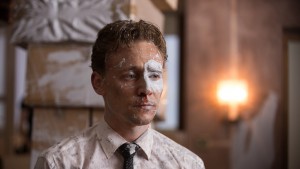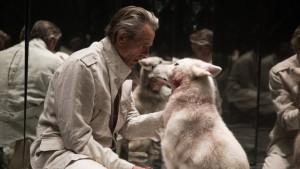 Ben Wheatley shows an impressive progress as a director with his new film, HIGH-RISE, an inventive, dystopian phantasmagoria based on J.G. Ballard’s 1975 Novel.
Ben Wheatley shows an impressive progress as a director with his new film, HIGH-RISE, an inventive, dystopian phantasmagoria based on J.G. Ballard’s 1975 Novel.
Bigger in scope and more ambitious than Wheatley’s previous efforts (Kill List, Sightseers), this nearly surreal, biting satire no doubt helped by the sharp narrative and impressive cast, starring Tom Hiddleston, Jeremy Irons, Sienna Miller, Luke Evans, Elisabeth Moss, Stacy Martin and James Purefoy.
 World premiering at the Toronto Film Fest, and then screening at the London, Tribeca, and Fantastic Film Fest, HIGH-RISE opens theatrically on Friday, May 13.
World premiering at the Toronto Film Fest, and then screening at the London, Tribeca, and Fantastic Film Fest, HIGH-RISE opens theatrically on Friday, May 13.
Based on Ballard’s celebrated novel, HIGH-RISE, which many directors have tried to adapt to the big screen before, is a futuristic parable that’s effective on any number of levels.
 The darkly wicked satire is set, literally and symbolically, in a towering, sharply stratified apartment building, where the social status of the residents ascends as the floors go up. Here is a microcosm of society, divided into a small, rich and powerful elite and the rest of the people (the masses), who belong to the middle and especially to the lower classes.
The darkly wicked satire is set, literally and symbolically, in a towering, sharply stratified apartment building, where the social status of the residents ascends as the floors go up. Here is a microcosm of society, divided into a small, rich and powerful elite and the rest of the people (the masses), who belong to the middle and especially to the lower classes.
 Hiddleston plays Robert Laing, a doctor has just moved into the upper level of the building with all the promised and desirable amenities. As such, he benefits from his privileged position as an outsider-insider.
Hiddleston plays Robert Laing, a doctor has just moved into the upper level of the building with all the promised and desirable amenities. As such, he benefits from his privileged position as an outsider-insider.
Gradually, he begins to encounter and get to know some of his neighbors at various but always strange social events, such as wild cocktail parties and drug fueled orgies.
 Among his new acquaintances and (sort of) friends are a faded actress (Sienna Miller), an unfaithful documentary filmmaker (Luke Evans) and his pregnant wife (Elisabeth Moss), and the upper class architect of the building (Jeremy Irons).
Among his new acquaintances and (sort of) friends are a faded actress (Sienna Miller), an unfaithful documentary filmmaker (Luke Evans) and his pregnant wife (Elisabeth Moss), and the upper class architect of the building (Jeremy Irons).
What propels the drama are a series of power outages, which become more and more frequent, and thus reveal the buildings’ flaws. Soon, the prevailing regimented and stratified social structure begins to show serious cracks before it crumbles.
 As a result, the psychological ambiance and social mores change, too, as nihilism, anomie, drugs and alcohol feed into wild expressions of sex and destruction (both self and socially oriented).
As a result, the psychological ambiance and social mores change, too, as nihilism, anomie, drugs and alcohol feed into wild expressions of sex and destruction (both self and socially oriented).
 Clint Mansell’s wicked music and Mark Tildesley’s strikingly original design evoke well the zeitgeist of the 1970s and 1980s, contributing to the overall impact of the biting tale.
Clint Mansell’s wicked music and Mark Tildesley’s strikingly original design evoke well the zeitgeist of the 1970s and 1980s, contributing to the overall impact of the biting tale.










